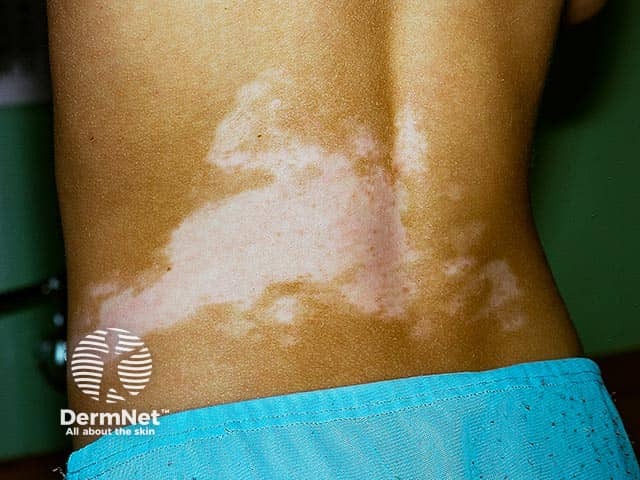Main menu
Common skin conditions

NEWS
Join DermNet PRO
Read more
Quick links
Author(s): Dr Lubna Siddiq, SMO, Cairns Base Hospital; and Dr Ian McColl, Dermatologist, Gold Coast, Australia (2023)
Reviewing dermatologist: Dr Ian Coulson
Edited by the DermNet content department
Introduction Demographics Causes Clinical features Variation in skin types Complications Diagnosis Differential diagnoses Treatment Outcome
Segmental pigmentation disorder (SegPD) refers to a subset of localised cutaneous pigmentary anomalies without systemic manifestations. It is characterised by unilateral hypo- or hyperpigmented patches, predominantly on the frontal torso with a sharp midline delineation.
SegPD was originally proposed as an entity in 1983. Over the years, it has been described under broader terminologies such as segmental pigmentation anomaly, patterned dyspigmentation, and pigmentary mosaicism. In 2010, the term ‘segmental pigmentation disorder’ was revived to reduce nosological confusion and separate it from other mosaic-patterned pigmentation disorders that have associated neural, ocular, or cardiac manifestations. This also helped in alleviating parental anxiety for those with children diagnosed with SegPD.

Block-like hyperpigmentation on the right abdomen with a sharp midline cut-off

Hyperpigmentation on the lower abdomen with a sharp cut-off at the midline

Depigmentation with minimal spread across the midline present since birth
Segmental pigmentation disorder is more commonly seen in darker-skinned individuals. It is usually detected in infancy and tends to persist into adulthood. The male-to-female ratio is roughly equal.
Segmental pigmentation (SegPD) is usually sporadic, although there have been reports of familial cases that may result from paradominant inheritance.
The precise aetiology of SegPD is unknown. Neural and hormonal factors affecting pigment cells, postzygotic somatic mosaicism, and cellular chimerism have been suggested as possible mechanisms.
Both melanocyte and neural crest cells originate from the ectoderm, which explains why certain pigmentation disorders are linked to nervous system manifestations. These are usually genetically determined disorders. SegPD, on the other hand, has an embryological determination that affects pigment migration for years following birth, without associated congenital neurological abnormalities.
SegPD is thought to present soon after birth, although may not be noted until early infancy or later due to the tendency of newborn skin to be lighter and less exposed to the sun.
Segmental pigmentation disorder is seen more commonly in people with darker skin types.
SegPD has no known complications. There is no convincing or consistent evidence that it is associated with any systemic disorders.
Segmental pigmentation disorder is usually diagnosed clinically, based on history and examination.
Histopathological findings via skin biopsy may overlap with other conditions. Hypopigmented lesions show less melanin than usual, but the number of melanocytes may be reduced or normal. Hyperpigmented SegPD lesions show increased melanin production in stratum basale.
Segmental hypopigmentation must be differentiated from:
Segmental hyperpigmentation must be differentiated from other pigmentation disorders, (particularly forms of pigmentary mosaicism) such as:
Segmental pigmentation disorder (SegPD) does not generally require any treatment.
Segmental pigmentation disorder lesions tend to stay stable in appearance and intensity with a tendency for hyperpigmented patches to fade over years.